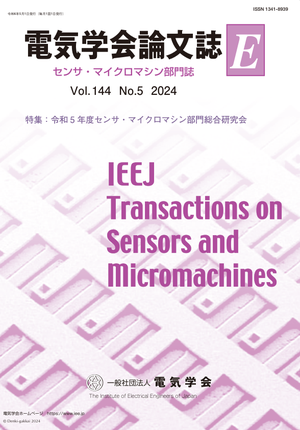Hypoxic Culture of Osteosarcoma Cells in PDMS Microfluidic Chamber and Plastic Bag
Hypoxic Culture of Osteosarcoma Cells in PDMS Microfluidic Chamber and Plastic Bag
カテゴリ: 論文誌(論文単位)
グループ名: 【E】センサ・マイクロマシン部門
発行日: 2024/05/01
タイトル(英語): Hypoxic Culture of Osteosarcoma Cells in PDMS Microfluidic Chamber and Plastic Bag
著者名: Rafia Inaam (Toyohashi University of Technology), Marcela Bolontrade (Institute for Translational Medicine and Biomedical Engineering (IMTIB) CONICET - University Institute of the Italian Hospital ), Shunya Okamoto (Toyohashi University of Technology), Ta
著者名(英語): Rafia Inaam (Toyohashi University of Technology), Marcela Bolontrade (Institute for Translational Medicine and Biomedical Engineering (IMTIB) CONICET - University Institute of the Italian Hospital ), Shunya Okamoto (Toyohashi University of Technology), Takayuki Shibata (Toyohashi University of Technology), Tuhin Subhra Santra (Indian Institute of Technology), Moeto Nagai (Toyohashi University of Technology)
キーワード: hypoxia,normoxia,sealed PDMS chips,osteosarcoma cells
要約(英語): Drug uptake into tumor cells is critical for therapeutic efficacy, and chemoresistance is a limiting factor in therapeutic success. Chemoresistance and tumor growth are modulated by hypoxia, a state of oxygen deprivation. To understand the role of hypoxia in chemoresistance, simple and user-friendly experimental reproducibility of hypoxic conditions is crucial. Therefore, hypoxic culture in a microfluidic chip needs to be more easily controlled with reduced manual intervention, ensuring the precision required in a microchip device. This paper reports hypoxic and normoxic cultures of osteosarcoma cells in a microfluidic chip and plastic bag. Cells in microfluidic chips and glass bottom dishes were compared in terms of cell health, cell length, and density. SAOS-2 cells in hypoxic culture had an average length of 18.6 μm for PDMS chips, while in all other cases, the average cell length was approximately 80 μm. Cell density also showed similar results with PDMS chips under hypoxia having the lowest cell density of 30 cells/mm2. The results indicated that the PDMS material was effective in replicating a hypoxic condition of the tumor microenvironment compared to the traditional approach. This study using a PDMS chip and plastic bag serves as a proof of concept for a lab-on-a-chip approach to evaluate tumor growth factors that mimic the tumor environment.
本誌: 電気学会論文誌E(センサ・マイクロマシン部門誌) Vol.144 No.5 (2024) 特集:令和5年度センサ・マイクロマシン部門総合研究会
本誌掲載ページ: 94-99 p
原稿種別: 論文/英語
電子版へのリンク: https://www.jstage.jst.go.jp/article/ieejsmas/144/5/144_94/_article/-char/ja/
受取状況を読み込めませんでした


